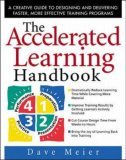Have you ever been bored out of your skull in class? Have you ever left a training session with absolutely no clue what it was about? Have you ever felt dumber at the end of a corporate training?
I have been to such bad training. I have given such awful training sessions.
The “Accelerated Learning Handbook” promises to free us from tedious, slow and ineffective 19th century training. Not a moment too soon!
Accelerated learning is based on a number of principles:
- Learning involves the whole mind and body
- Learning is creation, not consumption
- Collaboration aids learning
- Learning takes place at many levels simultaneously
- Learning comes from doing the work itself (with feedback)
- Positive emotions greatly improve learning
- The image brain absorbs information instantly and automatically.
The four phases
The training is organized into 4 cyclic phases. Each of these 4 steps are detailed, one chapter per phase.
- Prepare the learner. Get the learners out of a passive or resistive mental state; arouse their interest; give them positive feelings and a meaningful relationship with the subject; set clear, meaningful goals; create a positive physical and social environment. Don’t skimp on preparation!
- Presentation. The learning material is presented and the learner is actively involved. Use stories; show links with the real world; involve the body; use interactive presentations, colorful graphics and props. Apply a variety of techniques to appeal to all learning styles; let participants perform partner- or team-based projects; provide discovery exercises and real-world learning experiences. In traditional learning, this is by far the largest and longest phase. In Accelerated Learning, this is a small part of the overall training.
- Practice. Let the learner DO what you’ve presented, let them experience the new material, let them play with the information they were presented. Let participants try, give feedback, reflect and re-try. Use simulations, games and problem-solving activities; make time for individual and team-based reflection and articulation.
- Performance. Apply the learning immediately to the real world, evaluate, give feedback and correct. If the new knowledge is not immediately useful or used, it will fade away very quickly. Plan follow-through reinforcement activities; coach the learners; evaluate performance and give feedback regularly; set up peer support; ensure that the organisation is supportive of the changes.
These same four phases can be found in step 3 (“Transfer knowledge”) of the Toyota training model.
For each phase, the book gives techniques, tips and case studies. Further chapters give additional techniques, like the use of music, setting themes, the use of pictures and graphics, question-raising techniques, learning games (deserves several books on its own), the use (and misuse) of (information) technology… Plenty of useful tips and techniques to dip into when designing training.
Faster teaching
The learner learns faster with Accelerated Learning. The teacher can go faster too! The last part explains the Rapid Instructional Design techniques for developing effective training in record time. Rapid Design uses 7 principles:
- Design for the 4-phase learning cycle
- Appeal to all learning styles, make your learning SAVI (Somatic, Auditory, Visual and Intellectual).
- Make your designs activity based. Start by asking yourself what activities people can engage in before you start thinking about materials and presentation
- Create a learning community. Learning in pairs and groups works a lot faster than individual learning.
- Alternate between physically active and passive learning activities, like “Do, reflect, do…”
- Follow the 30/70 rule: approximately 30% of the time should be devoted to teacher activities (presenting, explaining, feedback), 70% for learner activities (trying, doing, reflecting).
- Create a flexible, open-ended design; be agile, go with the flow.
And what have we learned today?
 This method corresponds with the effective learning sessions I’ve experienced and created. I’ve used this model and the techniques to design training sessions or conference workshops. It works. Portia, Charles and I used these techniques to create and deliver a succesful BOF session at SPA in record time. Portia and I disregarded some of the principles (e.g. alternate between physically active and passive learning activities) when reworking the Real Options session, which resulted in a confusing session.
This method corresponds with the effective learning sessions I’ve experienced and created. I’ve used this model and the techniques to design training sessions or conference workshops. It works. Portia, Charles and I used these techniques to create and deliver a succesful BOF session at SPA in record time. Portia and I disregarded some of the principles (e.g. alternate between physically active and passive learning activities) when reworking the Real Options session, which resulted in a confusing session.
The book does have one serious drawback: it doesn’t use Accelerated Learning techniques! The book is all Presentation, there is no Practice or Perfomance. The book would have been a lot more effective if the explanations were followed by exercises where you could apply the techniques that were just explained. The authors should take a look at “Creativity Today“, which does this perfectly.
A big T-H-A-N-K Y-O-U to Portia for this gift. Come and experience our learning when we host a tutorial or workshop at an agile event near you.


